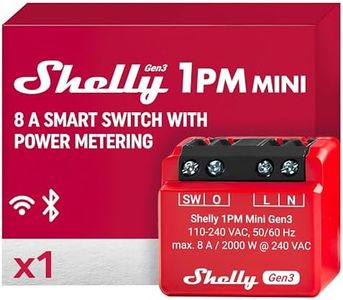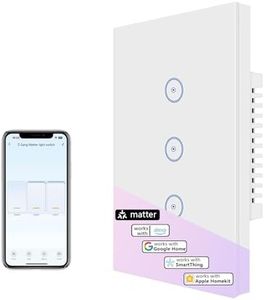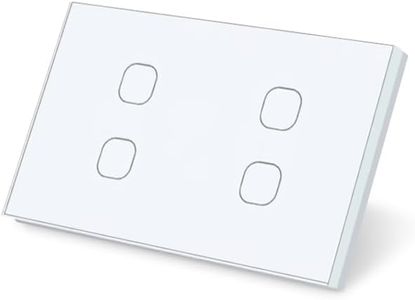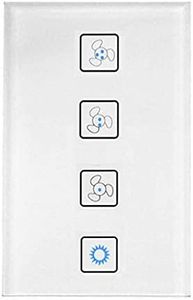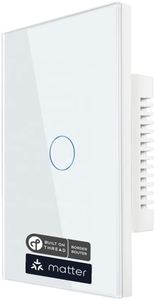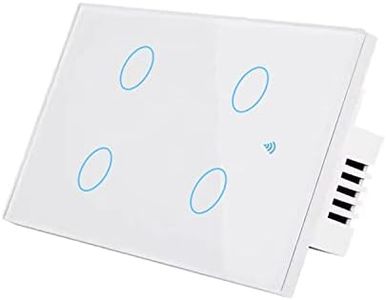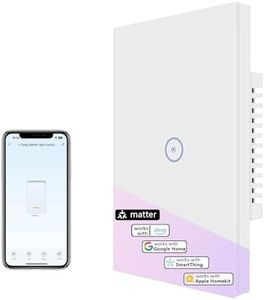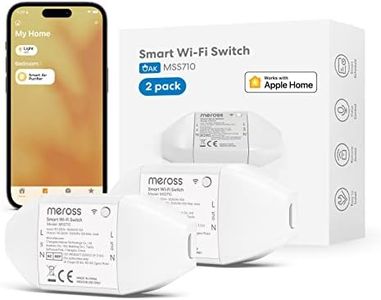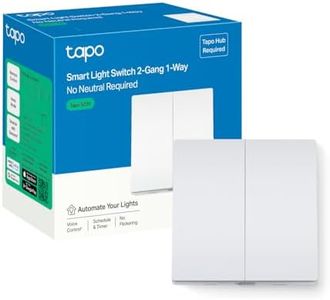We Use CookiesWe use cookies to enhance the security, performance,
functionality and for analytical and promotional activities. By continuing to browse this site you
are agreeing to our privacy policy
10 Best Smart Switches
From leading brands and best sellers available on the web.Buying Guide for the Best Smart Switches
Smart switches are devices that replace your traditional wall light switches and allow you to control your lights through your phone, voice assistants, or automation routines. Choosing the right smart switch can make your home more convenient, improve energy efficiency, and even enhance your security. When picking a smart switch, it's important to think not just about compatibility with your home's wiring and your preferred control method, but also about how you plan to use your lights on a daily basis.Wiring CompatibilityWiring compatibility refers to whether the smart switch will work with your home's existing electrical system. The most important aspect here is the 'neutral wire.' Many smart switches require a neutral wire for power, but some older homes may not have one in the switch box. Before buying, check if your wall box has a neutral wire, because getting an incompatible switch could mean a complicated installation or no installation at all. If you have a newer home (built in the last 20-30 years), you likely have neutral wires, but always double-check.
Control MethodThe control method describes how you interact with the smart switch. The main options are app control, voice control (through assistants like Alexa or Google Assistant), and sometimes built-in physical buttons with extra touch or dimming features. Some users want voice control for hands-free convenience, others prefer automating schedules in an app, and some just want a physical switch with added smart features. Think about your daily habits and which control you find the most natural or useful, and choose a switch that supports your preferred method.
Connectivity (Wi-Fi, Zigbee, Z-Wave, Bluetooth)Connectivity is the way your smart switch communicates with your home network and other smart devices. Wi-Fi switches connect directly to your internet, making them easy to set up, but they can crowd your network if you have many. Zigbee and Z-Wave switches need a hub but offer more stable connections for larger setups. Bluetooth is rare and usually for simple, phone-only use. Consider how many devices you plan to have and whether you want everything simple (Wi-Fi) or plan to build a larger smart home system (Zigbee/Z-Wave with a hub).
Load Type Support (LED, CFL, Incandescent, etc.)Load type support means the types of lights the switch can safely and effectively control, like LED, CFL, or incandescent bulbs. Some smart switches are more compatible with certain bulbs than others, especially when it comes to dimming. Using the wrong switch can cause flickering or may even damage the bulbs. Always check the bulbs in your home and make sure the switch you pick can handle their type and total wattage.
Dimmer FunctionalityDimmer functionality allows you to adjust the brightness of your lights through the smart switch itself, your phone, or by voice. If you like setting the mood with lighting or want to save energy, dimming is a great feature. Not all switches support dimming, and not all bulbs can be dimmed, so if you want this feature, make sure both your bulbs and switch are compatible.
Multi-way Compatibility (Three-way/ Four-way switching)Multi-way compatibility is about controlling a single light from multiple locations, like hallway lights with switches at both ends. If your current setup uses more than one switch for a single light, look for smart switches that support three-way or four-way wiring. You may sometimes need to buy a special companion switch. Ensure the switch supports the wiring scenario in your home before buying.
Size and DesignSize and design refer to the switch's physical look, feel, and compatibility with your home's wall plates and décor. Some switches are larger or shaped differently than standard switches, which could cause a tight fit in shallow wall boxes or look out of place aesthetically. Check dimensions and available colors, and think about whether you want touch controls, physical buttons, or a more traditional feel.
Installation ProcessThe installation process is how easy or difficult the smart switch is to install in your wall. While most are designed for DIY with simple tools, some might require connections that aren't present in every home. If you're comfortable switching out standard switches, most smart switches should only take about 15-30 minutes each. If wiring seems complicated or your home's setup is unusual, consider getting professional help.


